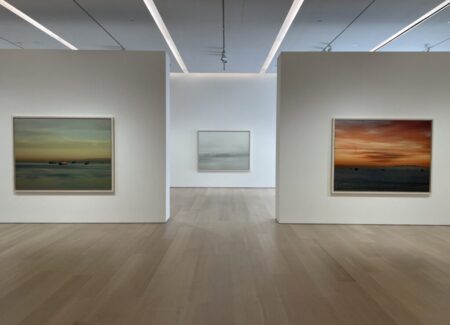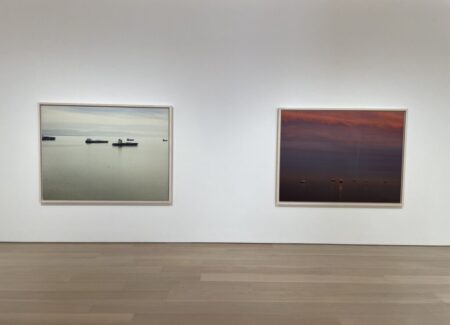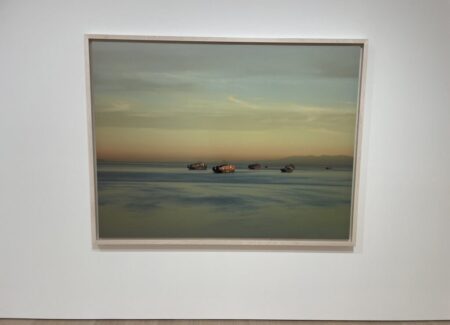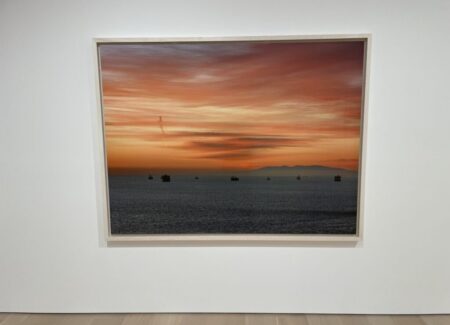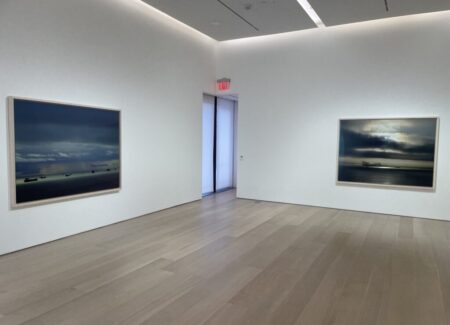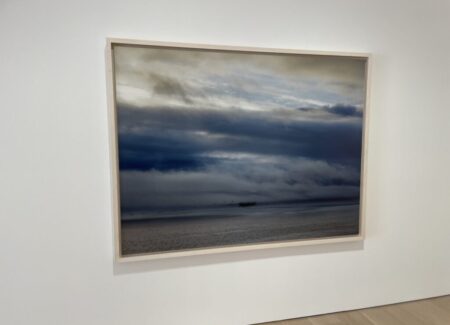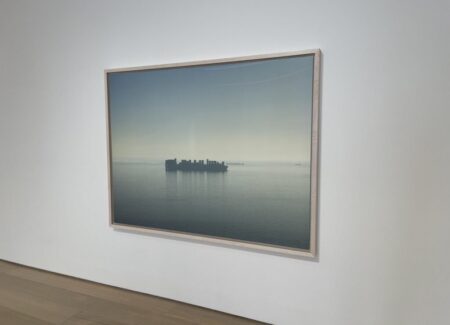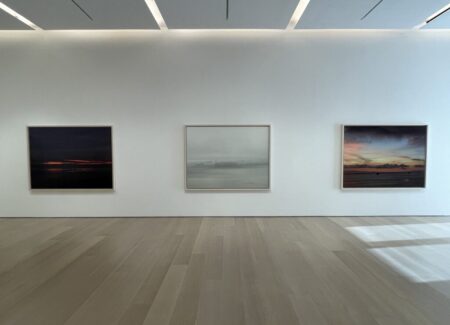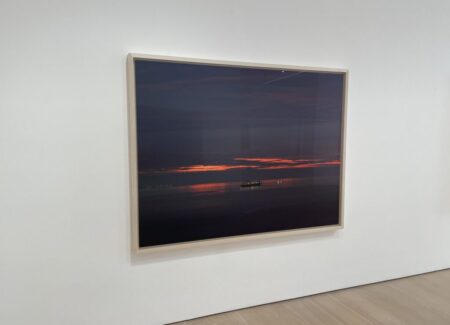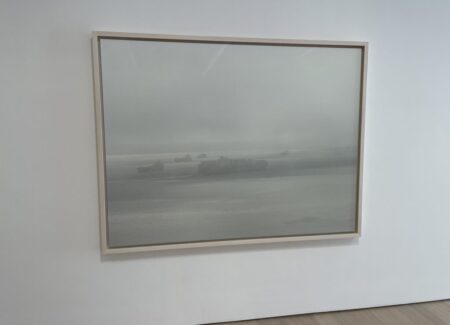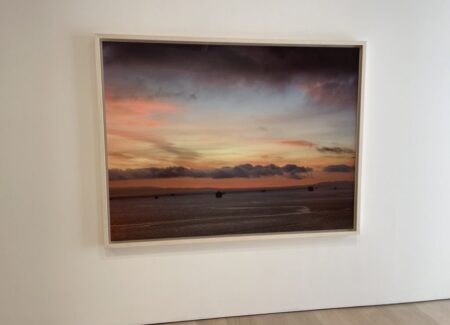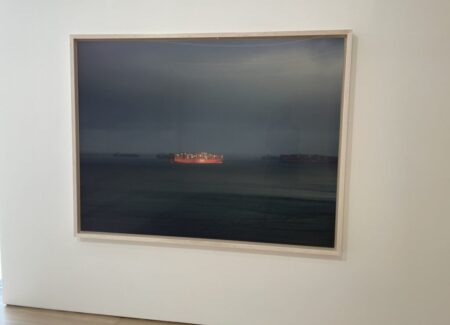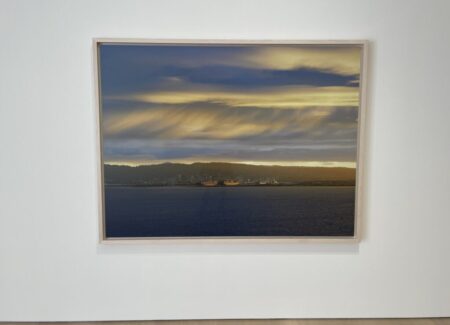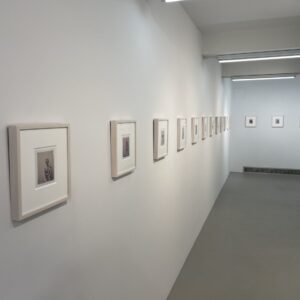JTF (just the facts): A total of 13 large scale color photographs, framed in light wood and unmatted, and hung in a divided gallery space on the second floor of the gallery. All of the works are pigment prints mounted on Dibond, made between 2021 and 2024. Each of the prints is sized roughly 58×79, 59×79, or 60×80 inches, and is available in an edition of 5+1AP. (Installation shots below.)
A monograph of this body of work is forthcoming from Aperture (here).
Comments/Context: Imagine you are a landscape photographer, or at least a photographer who is primarily interested in the land and how people interact with it, and the global pandemic arrives on your doorstep in 2020 and you are essentially confined to your home. Amid the quarantines and lockdowns, you could of course keep yourself busy by reviewing your archives and organizing your studio, but the unfulfilled desire to get out into the land and make new pictures would have been agonizingly frustrating. Given the constraints of the situation, perhaps you would eventually succumb to making images out the windows of your house or from the fixed position of your balcony, at least to keep sharp and pay close attention to something, even if it was the familiar landscape in your direct view.
At a high level, these were the circumstances facing the photographer Richard Misrach during the pandemic. Living in San Francisco, Misrach has an enviable view of the Bay from his home, and so during the lockdowns he started to point his camera out at what was available to him from that spot. The unlucky bad news was that he had already done something like this before; back in the late 1990s, he had made a now-celebrated series of large scale images of the Bay and the Golden Gate Bridge (to the west), capturing the dramatic changes in atmosphere and color across different times of day, different weather patterns, and different seasons, with sunsets and storms offering a consistently impressive visual show. So clearly Misrach couldn’t do that again; but the good news was that in 2021 when he was trapped inside by the pandemic, there was actually something going on out in the Bay (in the other direction, to the south and east) that serendipitously provided a potential new subject.
One of the big stories of the COVID era was just how disrupted global trade routes and supply chains became when factories were idled or closed for extended periods of time. Most of us experienced this as empty shelves at the grocery store, but that general supply and demand mismatch effect rippled its way back through various intermediate steps and stops along the way, with manufacturers waiting for component parts and deliveries delayed indefinitely. And it was a portion of this broader disruption that presented itself outside Misrach’s window, in the form of a backup of cargo ships waiting to get into the Port of Oakland to offload their shipments. With regular shipping schedules tossed into the wind (with endless permutations of early, late, or cancelled entirely) and maritime terminals short staffed, the cargo ships continued to arrive in San Francisco with no place to land. The only answer (aside from turning around) was to park in the Bay (or just outside) and wait until an unloading slot opened at the port; when the traffic was high, the waits measured in days and weeks, and the massive boats ended up anchored in bunches.
This stilted dance of international commerce conveniently took place right in front of Misrach’s camera, and over the next few years, he made countless images of these cargo ships patiently waiting their turn, set against the ever changing light and weather conditions of the San Francisco Bay. In a sense, these new “CARGO” pictures are an aesthetic relative of his earlier large scale Golden Gate Bridge sunsets and sky scenes, but with a different subject around which to orient the compositions. And in a similar way, the compositional variables are relatively few in number: the time of day (Misrach seems to have favored early morning/sunrise with the light behind for these images, with a few later day/sunsets with the light coming from the opposite direction), the relative proportions of sky and water, and the general placement of the ships in the scene. This small show presents a baker’s dozen of these views, offering a range of color palettes and compositional setups.
The most obvious of these photographs are of course the ones filled with grand dramatic sunrises, where the skies seem to overflow with outrageous combinations and gradients of pink, purple, and deep orange. The press release makes an artistic allusion to the seascapes of JMW Turner, and while that might sound like an overreach, many of Misrach’s photographs are indeed surprisingly painterly and atmospheric in a similar manner, with light diffusing and dissolving through wispy clouds and soft peachy mists. Many of these images have much more sky than water, using the silhouettes of the hills and the tiny cargo ships to populate the foreground. In one particularly dark sunrise, the deep simmering redness of the coming morning slashes through the darkness like a jagged mark by Clyfford Still, with the ships still running their lights from the overnight; in another, the color palette has shifted to a calmer yellow over blue, with the clouds muted to gestural hints.
But as any San Francisco resident can attest, not every morning is quite so glorious; many more are socked in by cold, wet fog, with little or no visibility across the Bay. Misrach gives us one version of this reality, with a morning view engulfed in thick whiteness, with the cargo ships reduced to approximate hulks in the enveloping mist, almost like unsettled ghosts haunting the waters. Another spooky view features the cranes at the port silhouetted against the rising sun, with dark bands of clouds blanketing the scene like eerie smoke. Still other images offer the fullness in the sky when stormier weather arrives, with dramatic banks of towering clouds, choppier water, and color palettes edged toward gun metal grey, deep blue, and black, with areas of light poking through the clouds here and there highlighting the waiting cargo ships lingering below. What’s fascinating about these various compositions is how much the implied mood can change from day to day or hour to hour, depending on the conditions.
Several other images redirect our attention away from these vast meteorological phenomena and back to the cargo ships themselves, pulling the scale back in. In one image, a single ship is silhouetted against clear skies and still waters, creating a flattened skyline effect almost like Stonehenge. In another, the late afternoon sunset flashes across the side of a ship, boldly illuminating it against the darkness, its multicolored containers and logo ONE seemingly spotlit. Other pictures feature a sinuous swirl of water, the reflections of shipboard lights on the nearby water, and even a single hoverboard rider jetting past the parked ships.
Conceptually, it is certainly possible to freight these “CARGO” photographs with discussions of international commerce, the invisible pathways of global capitalism, and maybe even the fragility these shipping networks experienced during the pandemic. But honestly that feels like a stretch; to my eye, these are simply finely wrought examples of 21st century maritime seascapes. Misrach has replaced the multi-masted merchant vessels in full sail of the 18th and 19th centuries with something more contemporary, and used photography rather than painting to craft his scenes, but the general impulse toward dramatic majesty seems remarkably similar. In this way, from his vantage point of pandemic-era confinement, Misrach has succeeded in updating an artistic genre that had been stuck in a bottle for a very long time.
Collector’s POV: The prints in this show are priced at $70000 each. Misrach’s work is routinely available in the secondary markets, with prices ranging from roughly $1000 to $125000, with his newer, much larger prints at the top end of that scale.
